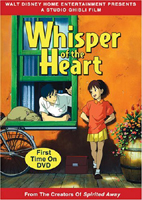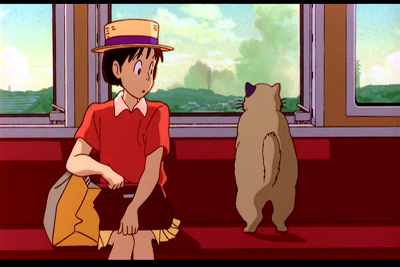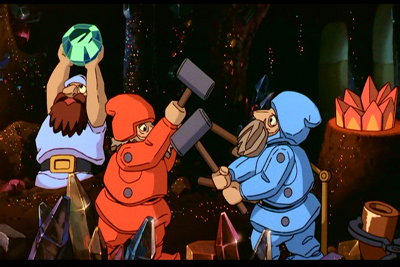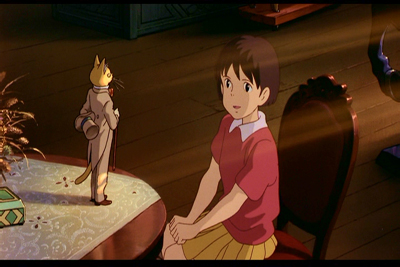 BUY IT AT AMAZON: CLICK HERE!
BUY IT AT AMAZON: CLICK HERE!
STUDIO: Disney
MSRP: $29.99
RATED: G
RUNNING TIME: 111 Minutes
SPECIAL FEATURES:
• Behind-the-scenes with voice talent
• Feature storyboards
The Pitch
"Judy
Blume in
The Humans
English
track: Brittany Snow (Namine in Kingdom Hearts 2) as
Shizuku, David Gallagher (7th Heaven) as Seiji.
Japanese
track: Youko Honna (The Cat Returns) as Shizuku, Kazuo Takahashi as Seiji.
The Nutshell
Shizuku
is just your average middle-school girl, hovering on the twin cusps of true
love and manic depression. The pace of Japanese schooling is beginning to do
her in, when a series of chance encounters leads her into a friendship with a
young boy named Seiji. The trouble is that Seiji is about to leave
high school education in favor of studying violin-making from a master in
the physical distance, and the distance between Shijuku’s low sense of
self-worth and her sense of Seiji’s great value?

Ask a stupid question. Go on, ask.
The Lowdown
Whisper of the Heart
is an
interesting blip on Studio Ghibli’s history. It was directed by Yoshifumi
Kondo, who was famed animator Hayao Miyazaki’s apprentice of sorts during his time
at Ghibli. It seemed to be common knowledge that
elder artist’s replacement, some time in the future. Unfortunately, Kondo died
young, only a year after completing Whisper, and
damn good films.
Kondo
couldn’t have known his death was around the corner as he worked on Whisper,
but there is a sort of resignation to the tone of the film, a weariness and
acceptance of fate. It’s just one of those things, I guess. Evidence that
sometimes the world slots together like a puzzle.
Whisper of the Heart is often described as a
fantastical story, but that’s not entirely accurate. Despite a sequence that
can’t help but put you in mind of Alice chasing after the white rabbit, most of
the film remains firmly grounded in real life, albeit a life of long and
glorious summers. There are only a couple of sequences that involve fantasy,
and even these are brief and kept strictly inside the imagination of Shizuku.

Just as Kipling predicted, the dwarves were so taken by the power of the Pot Belly Emerald
that they began to murder one another over who would be the next to hoist it aloft.
The core
of the relationship between Seiji and Shizuku is plenty interesting enough, and
doesn’t need the presence of fantasy to make it work for an audience. The two
children have a sort of mutual admiration society going on, where Shizuku
thinks Seiji is a wonderfully talented artist, and Seiji think Shizuku is smart
and witty. Shizuku’s low self-esteem drive her to unexpected territories when
Seiji goes off to apprentice in
write a novel. She goes through the frustrations of the writing process partly
to prove to herself that she’s good enough for Seiji, and partly just to see if
she can do it. It’s a distinctly Japanese relationship — the culture there
emphasizes excellence in young students to a degree that seems overcompensation
to a more Western audience.
Kondo
seems to inject some of that Western sensitivity into the story. There is a
particularly moving scene that takes place directly after Shizuku has given her
novel to Seiji’s grandfather, who gets to be the first to read the manuscript. It’s
a novel written by a fifteen year-old, so, even in the world of the film, it’s
not that great. Where the attitudes of the characters leading up to this point
makes the audience expect Shizuku to get gently beaten down and shuffled off to
a cram school, the grandfather expresses the sincerest fictional encouragement
I’ve encountered in a long time. He tells her it’s rough, and he tells her it
can be improved, and the emotion in his voice (especially in the original
Japanese) communicates far better than the words do.

"If I had a rat’s ass, my deah, I wouldn’t give it to hyou."
Moments
like that are what makes the movie an overall success, but it isn’t all full of
sincerity and sappiness. In a final estimation, the story isn’t especially
deep, nor given to finding those points of universality that give a film wide
appeal. It’s a story about two individuals, and the audience likely shares
little common ground with the experiences of those characters, so there’s not
much room on which to build sympathy. Instead of containing a moral or an aim
within itself, it instead inspires memories of similar events in viewers. It’s
a different way of forming audience connection, almost tangential, but it’s not
a quality of the movie itself, which suffers for it.
On the
technical side of things, the animation gets a bit wonky at times. The
backgrounds are stellar, as always with Ghibli movies, but the characters
undergo some noticeable proportion changes. Shizuku’s legs-to-torso ratio
expands and contracts so much that you could be forgiven for thinking her Stilt
Man’s younger sidekick.
Neither
of these are major obstacles for the simple enjoyment of the film, though you
may find yourself losing interest because of the first. Also as a result of the
insular story the conclusion comes too quickly and leaves without fully satisfying.
Whisper of the Heart is not at all a bad movie. It’s
not on par with
sweet and nostalgic. It’s major flaw is that its a collection of
inconsequentials, of minutiae of lives the audience has little investment in,
rather than a cohesive story.

You’ll never make it through that much Murakami in one [sitting/lifetime].
The Package
It would
only be a minor journalistic infraction to cut-and-paste this part from any of
our other Disney releases of Ghibli material. The bonus features seem to follow
some sort of standards bible, consisting of a behind-the-scenes look at the
English-language dub, and a second disc devoted to feature-length storyboards. Individually,
these are decent enough bonuses, but stacked next to other Ghibli discs, well,
one gets the feeling that there’s some sort of assembly line mentality going
into these, instead of the love they deserve.
Still, I
won’t complain, because Disney is doing a fantastic job with the audio and
transfers. Both of the audio tracks, Japanese and English, have been remixed
into Dolby 5.1, and both are well-balanced. Ambient effects, dialogue, and
music all co-exist with stepping on each other’s toes. So, you’ll be able to
see and hear the suburbs of
like never before!
7.0 out of 10